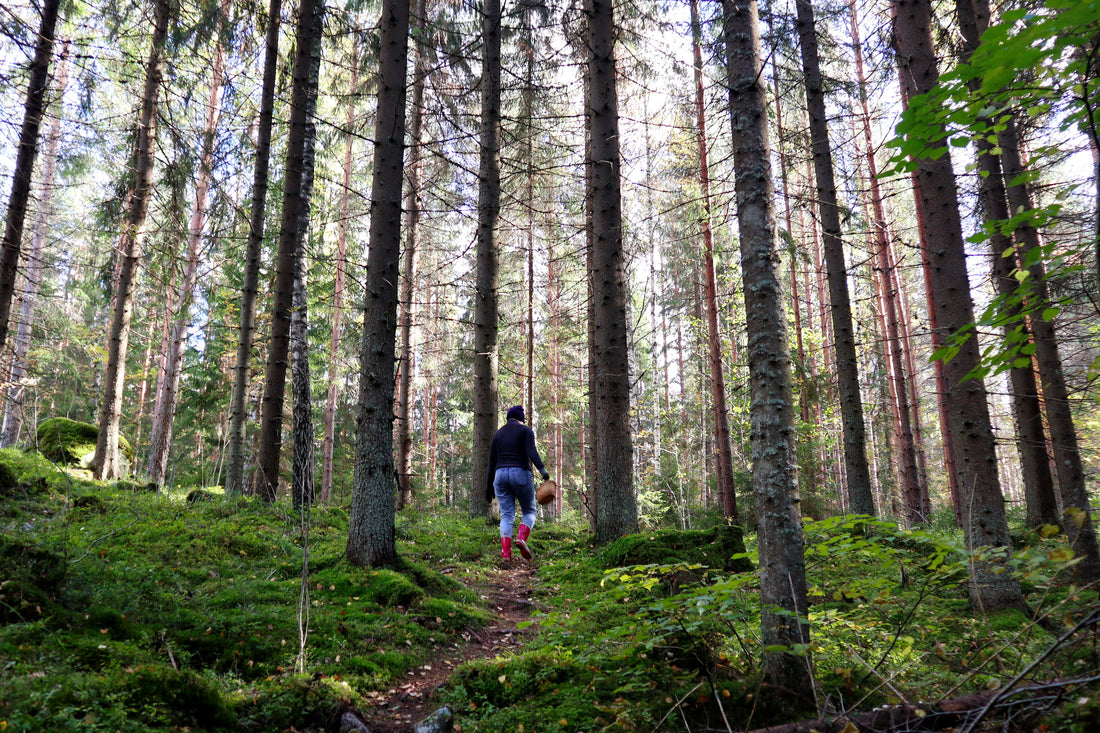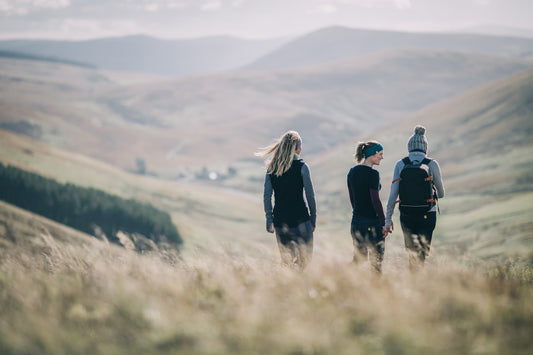As the year winds down and trees shed their last leaves, you might think that nature’s bounty has come to an end. But foraging in the UK at this time of year can still be a rewarding outdoor activity. While the pickings may be slimmer than in summer, there are still wild treasures to be found—if you know where to look!
Why Forage in Late Autumn?
Foraging in November and December brings a different kind of prize. Instead of berries and lush greens, you’ll find subtler foods, such as nuts, hardy herbs, and a few resilient mushrooms. It’s a mindful activity that encourages patience, observation, and a deeper appreciation for what the land offers as it closes down for winter. We also find that foraging during this time of year often brings peace and solitude, allowing you to escape the hustle and bustle of daily life.
What to Look For: Seasonal Finds in Late Autumn
Here are some of the foods to seek out during the colder months:
1. Sweet Chestnuts
- Where to Look: Woodland floors under sweet chestnut trees.
- How to Harvest: Wear gloves and look for fallen chestnuts encased in their spiky shells. Roast them for a delicious seasonal treat.
- Uses: Roasted chestnuts make a tasty snack, or you can use them in soups, stuffings, and desserts.

2. Beech Nuts
- Where to Look: Beech trees in forests and parks.
- How to Harvest: Gather beech nuts from the ground, removing the husks carefully.
- Uses: Beech nuts can be eaten raw, roasted, or ground into flour for baking.
3. Sloes
- Where to Look: Blackthorn bushes, typically in hedgerows.
- How to Harvest: Sloes are best picked after the first frost, which softens their skins and enhances flavour.
- Uses: Ideal for making sloe gin, jams, and jellies, as well as for adding a tart, wintry flavour to desserts.

4. Wild Mushrooms
- Where to Look: Woodland areas, especially damp, shaded spots.
- How to Harvest: Only pick mushrooms if you are confident in identifying edible species. Some popular late autumn varieties include oyster mushrooms, wood blewits, and winter chanterelles.
- Uses: Sauté mushrooms in butter, or add them to soups and stews. Ensure proper identification to avoid any poisonous varieties.
5. Nettles and Dandelions
- Where to Look: Open fields, meadows, and roadside verges.
- How to Harvest: Look for new growth; even in winter, nettles and dandelion greens may still emerge.
- Uses: Nettles and dandelion greens can be added to teas, soups, or used in a nutrient-rich salad. They are packed with vitamins and minerals—perfect for boosting your immune system.

Foraging Mindfully and Sustainably
With fewer foraging opportunities, it’s essential to forage responsibly and sustainably. Here are some simple guidelines to respecting the natural environment:
- Take Only What You Need: Harvest sparingly to ensure there’s enough for wildlife and other foragers.
- Use Local Guides: If you’re new to foraging, bring a field guide or go with someone experienced. This will ensure you pick the right species and avoid poisonous plants.
- Leave No Trace: Keep the landscape as you found it. Avoid pulling up roots and take care not to disturb the ecosystem.
- Be Mindful of Wildlife: Many plants, nuts, and berries are an essential food source for animals in winter, so be sure to leave enough for them.

The Joy of a Winter Walk with a Purpose
Foraging at this time of year brings an added purpose to your winter walks. It slows you down, encourages you to notice the smaller, often overlooked details in nature, and brings a bit of adventure to even the most familiar paths. And as you gather your small harvest of nuts, berries, or mushrooms, you’ll feel more in tune with the natural rhythms of the season—a wonderful antidote to the busyness of modern life.
So, grab a basket, bundle up in your cosiest layers, and enjoy a foraging walk that will leave you feeling refreshed, inspired, and connected to the unique beauty of late autumn.
We don’t recommend foraging for the first time without researching first. You need to know what to look for and how to do this safely. We find the following sources provide detailed, reliable information on foraging in the UK, specifically around late autumn and early winter:
- "Food for Free" by Richard Mabey – This is one of the most comprehensive foraging books for the UK, covering seasonal plants, berries, nuts, and mushrooms, as well as responsible foraging practices
- Wild Food UK (https://www.wildfooduk.com) – This website is a well-regarded resource for identifying edible plants and mushrooms, providing details on seasonal availability, recipes, and safety tips specific to the UK.
- Woodland Trust (https://www.woodlandtrust.org.uk) – The Woodland Trust offers a range of articles on foraging and seasonal plants, with advice on sustainable practices and species identification to support biodiversity.
- "The Forager’s Calendar" by John Wright – Another excellent seasonal foraging guide for the UK, it includes detailed descriptions of what’s available in each month and safe, sustainable foraging tips.
- Fungi UK (https://www.fungi.org.uk) – This website is specifically dedicated to fungi identification in the UK and is useful for anyone foraging mushrooms, with a strong emphasis on safety and responsible collection.
- The British Mycological Society (https://www.britmycolsoc.org.uk) – For those interested in mushroom foraging, the British Mycological Society provides resources for proper identification, including guides and recommendations for safe mushroom collection.
- National Trust (https://www.nationaltrust.org.uk) – The National Trust has a range of resources on foraging, with guides to autumn and winter finds like nuts, berries, and herbs, as well as ethical foraging guidelines.

Using these resources can provide guidance on plant identification, seasonal availability, and safe practices, making foraging an enjoyable and eco-friendly activity! Let me know if you'd like help with more specific foraging resources or tips for certain plants
Sunday Inspiration
Favourite Recipe
Sloe Gin by the Woodland Trust
If you are lucky enough to forage a good amount of sloe berries, this is a really simple way to make sloe gin. It is a sweet, syrupy drink, amazing over ice or with a little fizz for a festive drink.

- 1 litre bottle of gin
- 450g sloes
- 225g caster sugar
- 1 large sterilised jar or 2 empty gin bottles
Method
- Wash sloes and seal in an airtight bag. Freeze overnight or until you’re ready to make the gin.
- Put frozen sloes into sterilised jar or empty gin bottles.
- Add gin then the sugar directly onto frozen sloes. Their skins will split which means you can avoid the laborious pricking of each individual sloe berry.
- Once the sloes have thawed, seal jar tightly and shake well.
- Store jar in a cool, dark place and shake every other day for a week. After the first week you only need to shake it once a week for 2 months.
- The liquid should now be dark red and ready for drinking, although you'll find it improves over time.
Favourite Podcast
The Wild Food People Podcast is a weekly show about foraging, hunting, fishing, farming, ecology, conservation and all aspects of wild food.

Favourite Song
Any excuse to listen to Neil Young and perhaps one of his greatest songs. Harvest Moon is about life, loss and a special night under the full moon which rises during the autumnal equinox.




